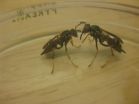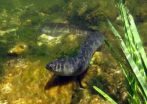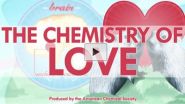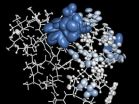(Press-News.org) Pancreatic stellate cells, which normally aid tissue repair, unwittingly help pancreatic cancer grow and spread in a method of 'cell hijack' only seen before in brain and breast cancer, according to new research from Queen Mary University of London.
The research, published in the latest issue of EMBO Molecular Medicine and carried out by Queen Mary's Barts Cancer Institute, also revealed the process can be blocked, thereby preventing the growth and spread of the tumour.
The study, funded by the UK charity Pancreatic Cancer Research Fund, set out to investigate the messaging mechanisms between cancer cells and the thick, fibrous stroma tissue that coats pancreatic tumours. It is this tissue which is believed to provide a nutrient-rich 'soil' in which cancer cells can grow.
Researchers found the cancer uses a protein called fibroblast growth factor receptor (FGFR) to hijack the stellate cells and force them to help the growth and spread of the tumour.
Ordinarily, FGF activates the stellate cells by binding to a receptor on the cell's surface. However, when examining donated human pancreatic cancer tissue, the researchers saw that FGFR had travelled directly to the nucleus, taking control and forcing the stellate cells to multiply and communicate with the cancer cells. This 'nuclear translocation' – which has only been seen in brain and breast cancer cells before - was most prominent in areas where the tumour was invading normal tissue.
Dr Stacey Coleman, lead author based at Queen Mary University of London, comments:
"We certainly weren't expecting to see this happening in pancreatic stellate cells but our results were emphatic. When we modelled what was happening and put activated stellate cells together with pancreatic cancer cells, the two-way signalling became more intense as the stellate cells and the cancer cells proliferated, in a vicious cycle of growth. When we blocked the FGFR activity and prevented the stellate cells from being hijacked, the cancer cells completely stopped growing and invading."
Pancreatic cancer often shows resistance to conventional chemotherapy, partly because the stroma prevents therapies reaching the tumour cells. The researchers believe these latest findings could pave the way for the development of a new combined therapy approach, able to both prevent the spread of cancer cells and weaken the stroma environment to allow chemotherapy to access the tumour.
Dr Stacey Coleman concludes:
"Our next steps are to investigate what changes occur when FGFR travels to the nucleus of stellate cells so we can find out how these cells may cause the stroma to develop and provide such a good environment for the cancer cells."
Maggie Blanks, CEO of the Pancreatic Cancer Research Fund, comments: "This is another example of the leading research we fund in the UK and I congratulate the Queen Mary team for their findings. Our research strategy is to enable the development of new treatments – whether alone or in combination with traditional therapies. These exciting findings suggest there's definitely something here that warrants further investigation that could prove significant for improving the treatment of pancreatic cancer."
INFORMATION:
Notes to the editor
Copies of the full paper are available on request.
About Queen Mary University of London
Queen Mary University of London is the "biggest star" among the UK's leading research-intensive higher education institutions, with five campuses in the capital: Mile End, Whitechapel, Charterhouse Square, West Smithfield and Lincoln's Inn Fields.
A member of the Russell Group, Queen Mary is also one of the largest of the colleges of the University of London, with 17,800 students - 20 per cent of whom are from more than 150 countries.
Some 4,000 staff deliver world-class degrees and research across 21 departments, within three Faculties: Science and Engineering; Humanities and Social Sciences; and the School of Medicine and Dentistry.
League table rankings
11th in the UK (Research Assessment Exercise, 2008), according to the Guardian
35th in the UK - Complete University Guide 2014
36th in the UK - Guardian University Guide 2014
114th globally and 14th in the UK - The Times Higher World University Rankings 2013-4
115th globally and 19th in the UK - 2013-4 QS World Rankings
Top 30 in the UK and in the top 201-300 bracket globally - Shanghai Jiao Tong Academic Rankings of World Universities 2013
Queen Mary has an annual turnover of £350m, research income worth £100m, and generates employment and output worth £700m to the UK economy each year.
Unique for London universities, Queen Mary has an integrated residential campus in Mile End - a 2,000-bed award-winning Student Village overlooking the scenic Regents Canal.
Pancreatic Cancer Research Fund (PCRF)
PCRF is the only UK charity exclusively funding research into pancreatic cancer. The charity has so far funded 27 research projects worth some £4 million across UK universities and these projects are funded entirely from public donations.
About pancreatic cancer
Each year approximately 8,800 people in the UK are diagnosed with pancreatic cancer. It is an extremely difficult cancer to diagnose and treat because it is unusually aggressive, symptoms are often vague and generally appear at an advanced stage of the disease. Around three per cent of those diagnosed with pancreatic cancer will survive for five years or more, a figure that has barely improved in forty years.
Study reveals unexpected cell hijack method in pancreatic cancer
2014-02-10
ELSE PRESS RELEASES FROM THIS DATE:
EORTC characterizes responders & survivors on pazopanib for advanced soft tissue sarcoma
2014-02-10
An EORTC analysis appearing in Annals of Oncology confirmed the importance of known prognostic factors such as performance status and tumor grading for having a long-term outcome in patients treated with pazopanib for metastatic soft tissue sarcoma. Additionally, hemoglobin at baseline was found to be a new prognostic factor.
Soft tissue sarcomas are a heterogeneous and relatively rare tumor with an estimated incidence of four per 100,000 people per year in Europe. The prognosis for patients with this disease is favorable if they are diagnosed at an early stage and if ...
Massive neutrinos solve a cosmological conundrum
2014-02-10
Scientists have solved a major problem with the current standard model of cosmology identified by combining results from the Planck spacecraft and measurements of gravitational lensing in order to deduce the mass of ghostly sub-atomic particles called neutrinos.
The team, from the universities of Manchester and Nottingham, used observations of the Big Bang and the curvature of space-time to accurately measure the mass of these elementary particles for the first time.
The recent Planck spacecraft observations of the Cosmic Microwave Background (CMB) – the fading glow ...
Wasps use ancient aggression genes to create social groups
2014-02-10
Aggression-causing genes appeared early in animal evolution and have maintained their roles for millions of years and across many species, even though animal aggression today varies widely from territorial fighting to setting up social hierarchies, according to researchers from Iowa State University, Penn State and Grand Valley State University.
If these "mean genes" keep their roles in different animals and in different contexts, then perhaps model organisms -- such as bees and mice -- can provide insights into the biological basis of aggression in all animals, including ...
Dental care in school breaks down social inequalities
2014-02-10
A new survey conducted by the University of Copenhagen and the World Health Organization (WHO) is highlighting the role of schools in work to promote health and prevent disease.
"Children in Scandinavia generally have healthy teeth and gums, largely on account of dental care in schools for all children, the arrival of fluoride toothpaste on the market, a healthy lifestyle and high living standards. But the situation in the poorest countries of the world is very different to that in Scandinavia. However, it is positive to note that the WHO's Health Promoting Schools Initiative ...
Threatened eels disappear in the deep on their way to the Sargasso Sea
2014-02-10
When the threatened European eels cross the Atlantic Ocean to get to the Sargasso Sea to spawn, they swim in deep water. But this does not protect them from predators, researchers from the University of Southern Denmark report: Even in deep water the eels are hunted and eaten.
The European eel is in decline, and all over the world biologists are struggling to map its mysterious life cycle in order to bring its numbers back up. One of the great puzzles is why and how the eel each year travels thousands of kilometers to get to the Sargasso Sea to spawn.
A European monitoring ...
The chemistry of love: Valentine's Day science from ACS Reactions
2014-02-10
WASHINGTON, Feb. 10, 2014 — Love has inspired timeless songs and sonnets — not to mention a few less-than-timeless romantic comedies. Now the chemistry of love is the subject of the latest episode of the American Chemical Society's Reactions YouTube series (formerly Bytesize Science). Just in time for Valentine's Day, the video is available at http://youtu.be/bp7Ydv5wAPk.
The video explains how feel-good neurotransmitters like dopamine and oxytocin fuel lifelong pair bonds in prairie voles, which — along with humans — are the mammalian kingdom's leading monogamists. "If ...
Sometimes the average just isn't good enough
2014-02-10
This news release is available in German. When averaging is good and when it's not
Usually averaging is a good thing that can make life a lot easier. For example, when you eat out with a group of friends and it comes to paying. If everyone had a meal and a drink and you split the bill total by the number of people, everyone will pay pretty close to what they would have paid for their individual meal and drink. However, if some people had a starter, a steak for main, a dessert and champagne while you had spaghetti and a soft drink, you will feel pretty much ripped ...
Oil composition boost makes hemp a cooking contender
2014-02-10
Scientists at the University of York today report the development of hemp plants with a dramatically increased content of oleic acid. The new oil profile results in an attractive cooking oil that is similar to olive oil in terms of fatty acid content having a much longer shelf life as well as greater heat tolerance and potentially more industrial applications.
Researchers in the Centre for Novel Agricultural Products (CNAP) in the Department of Biology at York say that high oleic acid varieties are a major step towards developing hemp as a commercially attractive break ...
New therapy for personality disorders proven more effective than other major treatments
2014-02-10
A large scale randomized control trial, just released in the American Journal of Psychiatry (the official journal of the American Psychiatric Association) shows Schema Therapy to be significantly more effective than two major alternative approaches to the treatment of a broad range of personality disorders (avoidant, obsessive compulsive, dependent, paranoid, histrionic, and narcissistic). Schema Therapy resulted in a higher rate of recovery, greater declines in depression, greater increases in general and social functioning and had a lower drop out rate. The results also ...
EHR-based screening program for AAA cuts the number of at-risk men by more than half
2014-02-10
PASADENA, CALIF., Feb. 10, 2014 — A screening program for abdominal aortic aneurysms, integrated into an electronic health record, dramatically reduced the number of unscreened at-risk men by more than 50 percent within 15 months, according to a Kaiser Permanente study published today in the Journal of Vascular Surgery. An abdominal aortic aneurysm is a balloon-like bulge in the aorta, which – if ruptured – can result in death. It is estimated that more than one million Americans are living with undiagnosed AAA, according to the Society for Vascular Surgery.
Since 2005, ...



